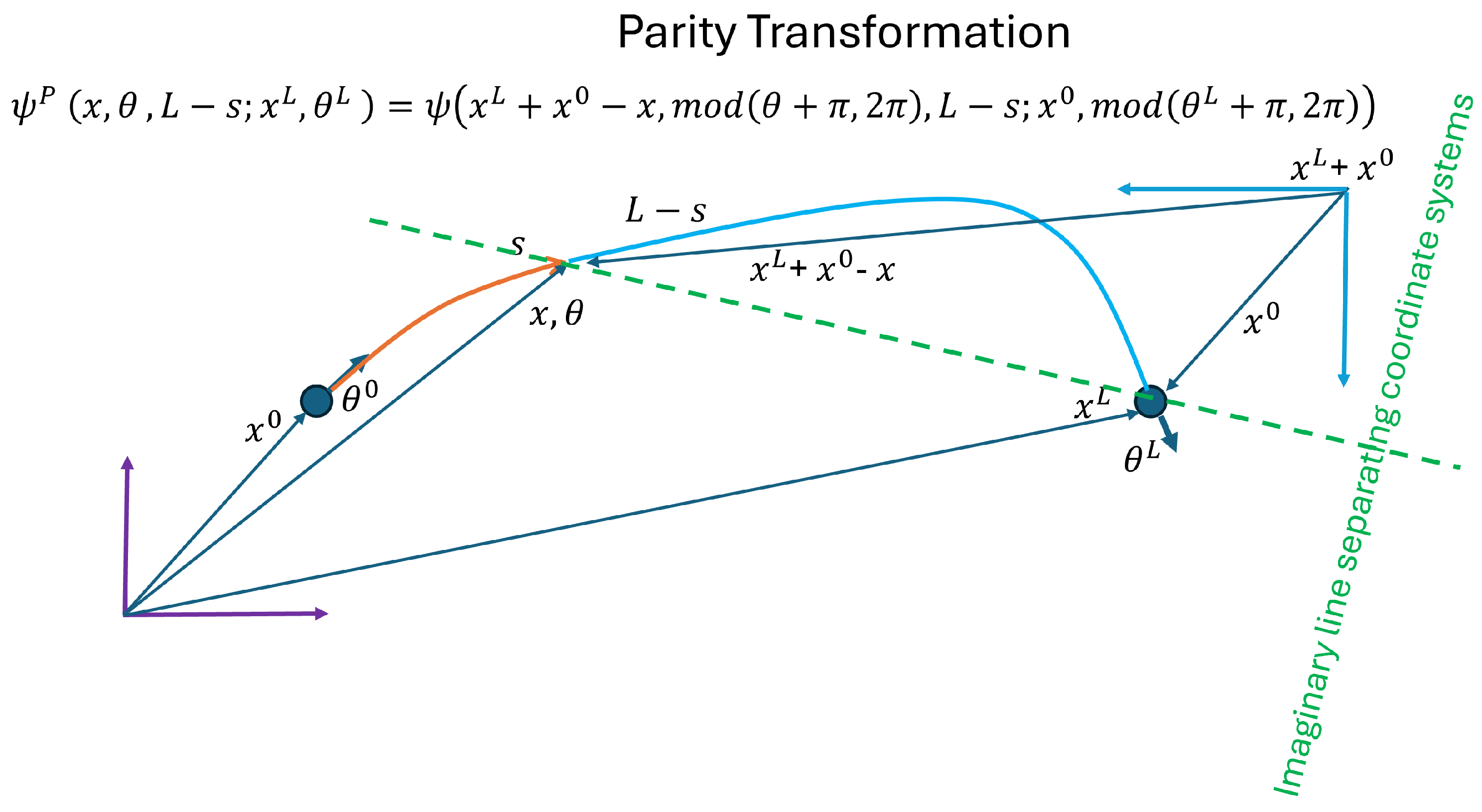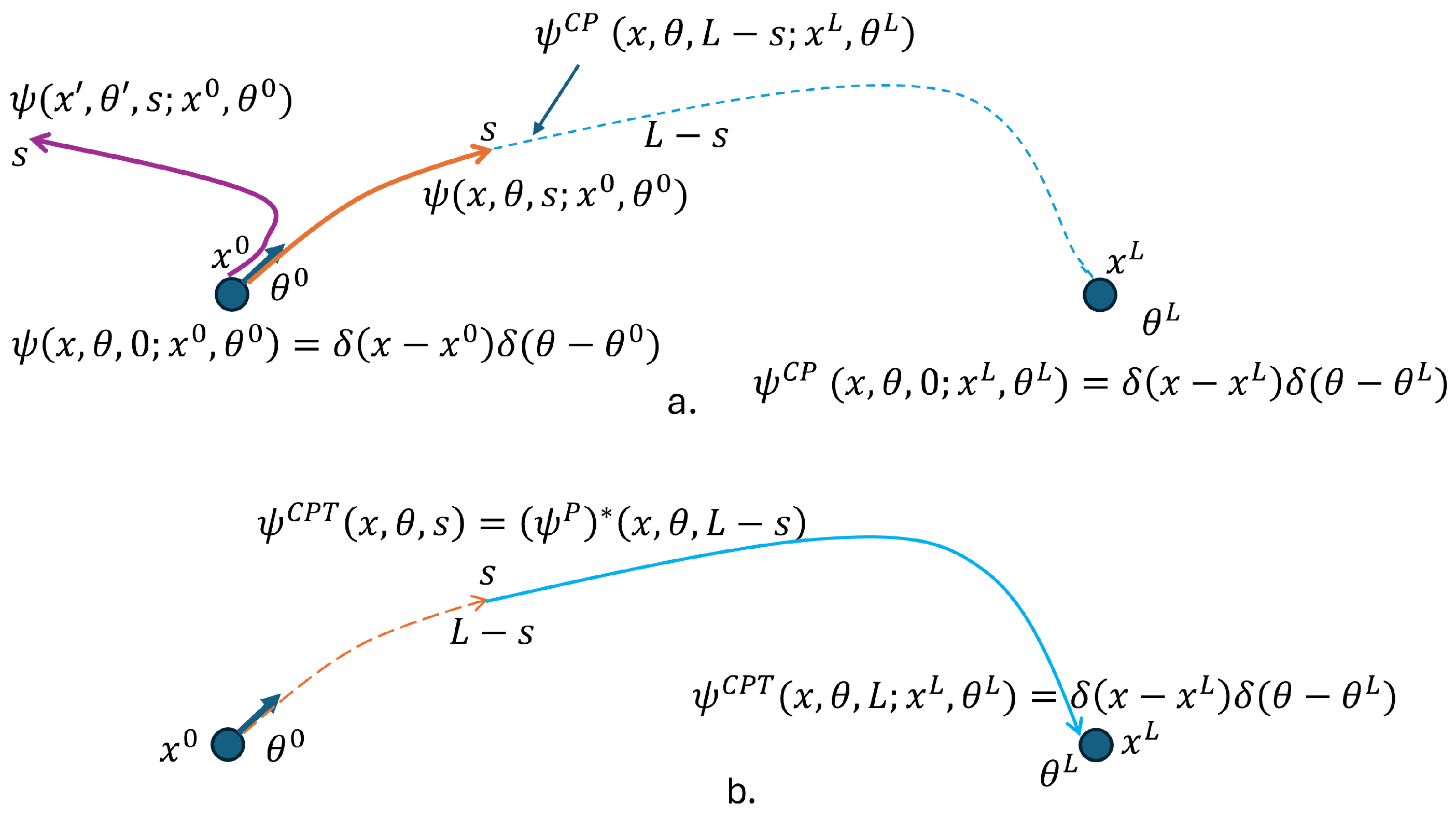Quantum Elastica
Abstract
1. Introduction
1.1. Quantum Method as a (New) Probabilistic Method
1.2. Possible Advantages of the Quantum Method
1.3. The Elastica Curve
1.4. A Brief History of Elastica
1.5. Organization
2. Quantum Method Considerations Beyond Physics
- Planck constant h, or the reduced one .
- A discrete set of energy states for atoms.
- The uncertainty principle, where measurements of one variable, say the position of a particle, imply complete unknown values to conjugate variables, the momentum of such a particle, and lead to many discussions on the role of measurement in physics.
2.1. Probability Methods from Dynamical Classical Models
2.2. The Path Integral Method
2.3. Measurements, Knowledge Acquisition, and Interpretation in the Quantum Method
3. Quantum Elastica Equation (QEE)
- 1.
- We discretize the path (arc length) into n equal-length intervals , with .
- 2.
- In the limit, ; i.e., . Then, , and , where , i.e,
- 3.
- Given the elastica action (1), the infinitesimal action element from to iswhere and .
- 4.
- So, the elastica action can be written asFollowing the path integral method, we create the infinitesimal propagator
3.1. The Parameter and Wick Rotation
3.2. Some Properties of the QEE
3.3. Boundary Conditions
4. The Backward QEE
5. Elastica Quantum Wave and Probabilities
6. Conclusions
Author Contributions
Funding
Institutional Review Board Statement
Informed Consent Statement
Data Availability Statement
Acknowledgments
Conflicts of Interest
Appendix A. SE(2) Fourier Hamiltonian Equation
Appendix B. Proofs of Lemmata
- Differentiating P (see Definition 1) induces the following differential P operators and .
- Applying P to the functions cosine and sine of implies that .
References
- Wheeler, J.A.; Feynman, R.P. Classical Electrodynamics in Terms of Direct Interparticle Action. Rev. Mod. Phys. 1949, 21, 425–433. [Google Scholar] [CrossRef]
- Kirkpatrick, S.; Gelatt, C.D., Jr.; Vecchi, M.P. Optimization by Simulated Annealing. Science 1983, 220, 671–680. [Google Scholar] [PubMed]
- Hopfield, J.J.; Tank, D.W. “Neural” computation of decisions in optimization problems. Biol. Cybern. 1985, 52, 141–152. [Google Scholar] [CrossRef]
- Hopfield, J.J. Neural networks and physical systems with emergent collective computational abilities. Proc. Natl. Acad. Sci. USA 1982, 79, 2554–2558. [Google Scholar]
- Shor, P.W. Polynomial-Time Algorithms for Prime Factorization and Discrete Logarithms on a Quantum Computer. SIAM J. Comput. 1997, 26, 1484–1509. [Google Scholar]
- Dirac, P.A.M. The Principles of Quantum Mechanics; Oxford University Press: Oxford, UK, 1981. [Google Scholar]
- Wikipedia Contributors. Quantum Algorithm—Wikipedia, The Free Encyclopedia. 2022. Available online: https://en.wikipedia.org/w/index.php?title=Quantum_algorithm&oldid=1103925546 (accessed on 12 August 2022).
- Farhi, E.; Goldstone, J.; Gutmann, S. A Quantum Approximate Optimization Algorithm. arXiv 2014, arXiv:1411.4028. http://arxiv.org/abs/1411.4028.
- Blekos, K.; Brand, D.; Ceschini, A.; Chou, C.H.; Li, R.H.; Pandya, K.; Summer, A. A review on Quantum Approximate Optimization Algorithm and its variants. Phys. Rep. 2024, 1068, 1–66. [Google Scholar] [CrossRef]
- Arrazola, J.M.; Delgado, A.; Bardhan, B.R.; Lloyd, S. Quantum-inspired algorithms in practice. Quantum 2020, 4, 307. [Google Scholar] [CrossRef]
- Dunjko, V.; Wittek, P. A non-review of Quantum Machine Learning: Trends and explorations. Quantum Views 2020, 4, 32. [Google Scholar] [CrossRef]
- Woodhouse, N.M.J. Geometric Quantization; Oxford University Press: Oxford, UK, 1997. [Google Scholar]
- Feynman, R.P. Space-Time Approach to Non-Relativistic Quantum Mechanics. Rev. Mod. Phys. 1948, 20, 367–387. [Google Scholar] [CrossRef]
- Feynman, R.P.; Hibbs, A.R.; Styer, D.F. Quantum Mechanics and Path Integrals; Dover Publications: Mineola, NY, USA, 2010. [Google Scholar]
- Cicconet, M.; Geiger, D.; Werman, M. Complex-valued hough transforms for circles. In Proceedings of the 2015 IEEE International Conference on Image Processing (ICIP), Quebec City, QC, Canada, 27–30 September 2015; pp. 2801–2804. [Google Scholar] [CrossRef]
- Cicconet, M.; Geiger, D.; Werman, M. Quantum Pairwise Symmetry: Applications in 2D Shape Analysis. arXiv 2015, arXiv:1502.00561. [Google Scholar]
- Geiger, D.; Kedem, Z.M. Quantum Interference and Shape Detection. In Energy Minimization Methods in Computer Vision and Pattern Recognition; Pelillo, M., Hancock, E., Eds.; Springer: Cham, Switzerland, 2018; pp. 18–33. [Google Scholar]
- Levien, R. The Elastica: A Mathematical History; Electrical Engineering and Computer Sciences University of California at Berkeley: Berkeley, CA, USA, 2008; p. 70. [Google Scholar]
- Matsutani, S. Euler’s Elastica and Beyond. J. Geom. Symmetry Phys. 2010, 17, 45–86. [Google Scholar] [CrossRef]
- Born, M. Untersuchungen über Die Stabilität der Elastischen Linie in Ebene und Raum, Under Verschiedenen Grenzbedingungen. Ph.D. Thesis, University of Göttingen, Göttingen, Germany, 1906. [Google Scholar]
- Mumford, D. Elastica and computer vision. In Algebraic Geometry and Its Applications; Springer: Berlin/Heidelberg, Germany, 1994; pp. 491–506. [Google Scholar]
- Tai, X.C.; Hahn, J.; Chung, G.J. A fast algorithm for Euler’s elastica model using augmented Lagrangian method. SIAM J. Imaging Sci. 2011, 4, 313–344. [Google Scholar] [CrossRef]
- Grimm, V.; McLachlan, R.I.; McLaren, D.I.; Quispel, G.; Schönlieb, C. Discrete gradient methods for solving variational image regularisation models. J. Phys. A Math. Theor. 2017, 50, 295201. [Google Scholar]
- Zhang, J.; Chen, R.; Deng, C.; Wang, S. Fast linearized augmented Lagrangian method for Euler’s elastica model. Numer. Math. Theory Methods Appl. 2017, 10, 98–115. [Google Scholar]
- Zhu, W.; Tai, X.C.; Chan, T. Image segmentation using Euler’s elastica as the regularization. J. Sci. Comput. 2013, 57, 414–438. [Google Scholar]
- Kang, S.H.; Zhu, W.; Jianhong, J. Illusory shapes via corner fusion. SIAM J. Imaging Sci. 2014, 7, 1907–1936. [Google Scholar]
- Keemink, S.W.; van Rossum, M.C. A unified account of tilt illusions, association fields, and contour detection based on elastica. Vis. Res. 2016, 7, 164–173. [Google Scholar]
- Dirac, P.A.M. The Lagrangian in Quantum Mechanics. Phys. Z. Der Sowjetunion 1933, 3, 64–72. [Google Scholar]
- Kac, M. On Distributions of Certain Wiener Functionals. Trans. Am. Math. Soc. 1949, 1, 1–13. [Google Scholar]
- Shannon, C.E. A mathematical theory of communication. Bell Syst. Tech. J. 1948, 27, 379–423. [Google Scholar] [CrossRef]
- Geiger, D.; Kedem, Z.M. On Quantum Entropy. Entropy 2022, 24, 1341. [Google Scholar] [CrossRef]
- Einstein, A.; Podolsky, B.; Rosen, N. Can Quantum-Mechanical Description of Physical Reality Be Considered Complete? Phys. Rev. 1935, 47, 777–780. [Google Scholar] [CrossRef]
- Peres, A. Einstein, Podolsky, Rosen, and Shannon. Found. Phys. 2005, 35, 511–514. [Google Scholar] [CrossRef][Green Version]
- Wick, G.C. Properties of Bethe-Salpeter Wave Functions. Phys. Rev. 1954, 96, 1124–1134. [Google Scholar] [CrossRef]
- Schlingemann, D. From Euclidean Field Theory to Quantum Field Theory. Rev. Math. Phys. 1999, 11, 1151–1178. [Google Scholar]
- Zee, A. Quantum Field Theory in a Nutshell, 2nd ed.; Princeton University Press: Princeton, NJ, USA, 2010. [Google Scholar]
- Dirac, P.A.M. The quantum theory of the emission and absorption of radiation. Proc. R. Soc. Lond. Ser. A Contain. Pap. A Math. Phys. Character 1927, 114, 243–265. [Google Scholar]
- Feynman, R. The Reason for Antiparticles. In Elementary Particles and the Laws of Physics, The 1986 Dirac Memorial Lectures; Feynman, R.P., Weinberg, S., Eds.; Cambridge University Press: Cambridge, UK, 1987. [Google Scholar]
- Arute, F.; Arya, K.; Babbush, R.; Bacon, D.; Bardin, J.C.; Barends, R.; Biswas, R.; Boixo, S.; Brandao, F.G.; Buell, D.A.; et al. Quantum supremacy using a programmable superconducting processor. Nature 2019, 574, 505–510. [Google Scholar]
- IBM Quantum Computing Activities 2022. Available online: https://research.ibm.com/quantum-computing (accessed on 24 March 2025).
- Google Quantum Computing Inches Closer to Reality After Anohter Google Breakthrough. New York Times 2024. Available online: https://www.nytimes.com/2024/12/09/technology/google-quantum-computing.html?smid=nytcore-androidshare (accessed on 24 March 2025).
- Gantmacher, F.R.; Krein, M. Oscillation matrices and kernels and small vibrations of mechanical systems. Amer Mathematical Society/Chelsea Publication Series. 1961. Available online: https://bookstore.ams.org/chel-345-h (accessed on 24 March 2025).


Disclaimer/Publisher’s Note: The statements, opinions and data contained in all publications are solely those of the individual author(s) and contributor(s) and not of MDPI and/or the editor(s). MDPI and/or the editor(s) disclaim responsibility for any injury to people or property resulting from any ideas, methods, instructions or products referred to in the content. |
© 2025 by the authors. Licensee MDPI, Basel, Switzerland. This article is an open access article distributed under the terms and conditions of the Creative Commons Attribution (CC BY) license (https://creativecommons.org/licenses/by/4.0/).
Share and Cite
Geiger, D.; Werman, M. Quantum Elastica. Entropy 2025, 27, 388. https://doi.org/10.3390/e27040388
Geiger D, Werman M. Quantum Elastica. Entropy. 2025; 27(4):388. https://doi.org/10.3390/e27040388
Chicago/Turabian StyleGeiger, Davi, and Michael Werman. 2025. "Quantum Elastica" Entropy 27, no. 4: 388. https://doi.org/10.3390/e27040388
APA StyleGeiger, D., & Werman, M. (2025). Quantum Elastica. Entropy, 27(4), 388. https://doi.org/10.3390/e27040388






